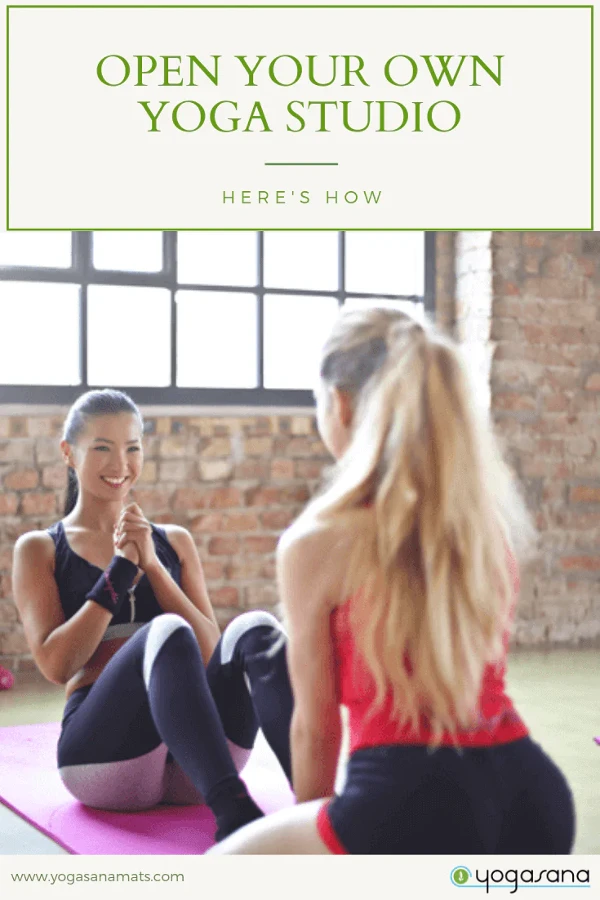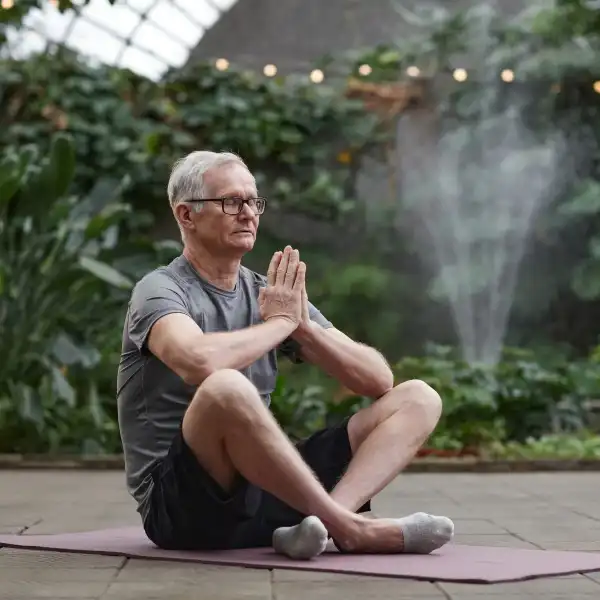Ever dream about opening your own yoga studio, but doubted it could actually happen? Trust us – you can do it. Here’s the proof.
Mind Body Green recently interviewed the founder of Y7 Yoga Studios – Sarah Levey – about her experiences running a studio. In case you’re not familiar, Y7 is an extremely popular studio with four locations in Manhattan, one in Brooklyn, and one in L.A. And while you might be quick to assume Ms. Levey is one of those rare beings who was gifted the ability to run her own successful studio, think again.
She’s not so different from the rest of us.
Before she opened her first studio, Levey was working as an accountant in the fashion industry while looking to start her yoga practice. Yet she struggled to find the right studio to met her needs. “I didn’t want to be forced into a certain mindset of a teacher or into poses that weren’t right for my body,” she told MBG.
That passion for finding the “right” studio turned into a revelation – maybe she had to make her own studio. And, with hard work and dedication she did. But here’s the thing – it wasn’t until she had opened up her third studio that she stopped working full-time at her other career. She realized she had something here and, if she wanted it to succeed, she needed to commit to it full time.
“Squarespace is so much more than a hosting platform. We are able to customize everything. Our brand image and feel is so important to us, and being able to have a place where we can bring what we think to life has been amazing,” she said.
Still, you might be wondering, how did Levey find such tremendous success? In reality, it comes down to her unique selling proposition. She wanted every single person coming into the studio to feel like they were entering an inclusive environment. She didn’t want new yogis walking into the studio to a ton of Sanskrit or symbols that they didn’t understand—she didn’t want them feeling like they felt like they were already on the outside the moment they walked in.
“Yoga is for everyone. Every type of body, every type of person. We aim to provide a safe space where anyone walking in feels comfortable to be themselves and take what they need out of the experience.”
Now that you know that it is possible to start your own yoga studio, are you excited to start yours?
Read on as we lay out what you need in order to get this business idea of yours up and going.
What You Need
To start off, you need to have a solid business plan. Your love for yoga is not going to be enough to sustain a business. There are things that you need to plan.
Here are some questions to ask yourself when constructing your business plan:
- Are you going to offer different styles of yoga or just one particular style?
- Are the classes going to be heated, unheated, or both?
- Are you going to lean towards modern yoga or stick to traditional?
- What kind of clientele are you looking to serve?
- What will be the size of your classes?
- Are you going to eventually offer workshops, retreats and training in the future?
- How many classes will you be holding per day?
- Who will tend to the other classes? Are you going to teach all of the classes?
- What kind of music (if there is) will you be playing?
- Are your classes going to be focused? Or more of a large scale classes?
These are just some of the basic questions that you have to answer when building your business plan.
Your answer will then determine the next things that you will need for your yoga studio.
Just a small example; if you don’t plan to have big classes then you can move on to the next step knowing exactly what size of studio you will get. Whether you rent a place just when you have classes, or you lease a whole place, it will start from these basic questions.
While you are going through the basic information of your yoga studio, take note of every detail that you can think of. In business, there is no such thing as a small detail. It might be useful in the future so it’s better if you consider and take note of everything.
Other Considerations

Now that you already have a detailed blueprint of your business plan, it’s time to consider the next step. Lara Estrada, owner of Yoga Bliss in Los Angeles, California leaves tips for those who want to start their own yoga studio.
Study startup costs – knowing every small detail about your business plan will help you consider the startup costs. How much should you leave for the budget of your rental space?
As an example, Lara noted that a simple boutique studio that can hold about 25 students at a time while having an adequate space for retail and a small lobby would be around 1100 square feet. Armed with this information, you can go on and canvass the possible prices of the studios around you.
Maria Turco, founder of Honor Yoga Studios believes that your studio will not be successful if it’s not in the right place. As a guide, she says that the lease that you will pay should not be more than 20% of your revenue. This is to ensure that not all your money is going to your rent. She also added that having a tenant improvement allowance from the owner is a big help, this is where the owner will significantly improve the space before your rent, instead of just giving you a bare unpainted space.
Another consideration she believes is important is to have adequate parking spaces for your students. This is one thing that you should never under estimate according to Turco.
Now that you have the space, you can start calling contractors and designers to get a quote on how much you are looking to spend in constructing your studio.
Other considerations are as follows:
- Business registration – before you open your studio, make sure you register as an LLC and register for taxes. You can approach a registered agent if you don’t know how to start.
- Secure bank accounts – when you have a business, you have to open a separate bank account that will solely be used for accounting purposes. Mixing your personal expenses with your business expenses is not a good idea at this point.
- Permits, licenses, and insurance – these are important aspects that you can’t forget before opening. To avoid being shut down or paying fines, secure the proper permits and licenses.
- Accountant – you can opt to hire an accountant to handle your finances, to make sure you have your business computations up to date from day 1. You can also do this yourself if you have enough experience. Just remember that not putting effort to maintain a good accounting status may cause you more in the long run.
- Team – Hiring a back office team is also an option. You can find people who can double as your teachers as well as help in the management of the business. Or you can solely teach the classes if you want. This will all depend on your business plan.
- Price range – Check out other yoga studios around you to get an idea about the average price range of their classes. As a guide, a number of yoga studios start by offering yoga classes for $12 per class if the participants pay a per-class basis. For multiple classes, it can go down to $9-$15. Monthly membership is also an option and can be about $190 per month.
Mistakes to Avoid
Finding a mentor in any endeavor that you start. One of the best reasons why you need it is that they can spare you from repeating the same mistakes as they did when they are starting. They can also guide you through a more personal path that can prove useful to you and what you are starting.
However, in most cases, having a mentor is not doable for everybody. If you can’t find a mentor for you, Very Well Health has a very useful article where they
- Preparation – most failed businesses fail because of starting in a rush. Instead of taking time to study the environment and workings of the business, some start with just their passion. While passion is important, proper planning will secure you better.
“Just getting started was tough—finally visiting a bank with our financials, submitting a letter of intent on a lease, looking into copyrighting, and contacting contractors and equipment providers,” says Brie Galenciano when she opened her yoga studio. “Even researching and looking at spaces for the studio took us a whole year.”
- Weak team – Failing to properly assess your strengths and weaknesses from the beginning may cause you to continue and build a weak team. A good team is having other people whose strengths can help you with your weaknesses.
- Disregarding the business part – Opening a successful yoga studio includes having a balance of passion and management. Planning your expenses properly may save you from premature and unexpected expenses. These outlining costs includes the following; accounting, insurance, rent, advertising, salaries for your team, utilities, taxes.
- Being easy on marketing – Expecting people to find your yoga studio on their own once you open is not a very good idea. Consider having a website and securing your social media channels. A good social media presence can help you reach your proper audience and patrons.
- Not maximizing your income – A good way to maximize your income is to provide a retail space on your studio. You can also provide one-on-one or persona coaching for a higher price. Some yoga studios also put up their space for rent for events and other classes when they don’t have scheduled classes.
- Not persevering enough – Starting a business is not an easy way to financial freedom. There will be a lot of months where you may think that you are getting no progress. But if you hold on much longer, oftentimes, you may find that the success you are looking for is just around the corner.
In Conclusion
To sum this up, starting your own yoga studio is possible, but maintaining a successful one will not be possible without the proper preparations and considerations.
Before you go and start your own yoga studio, let us leave you with our own top three tips to walk by when you start your journey.
- Be true to your principles. Do not stray away from the principles that you embody in your yoga practice. This will ensure that you get your loyal customers that will believe in the same principles that you believe in.
- Love the environment. More and more people are now becoming more aware of the dangers that some materials and practices do to the environment. If you want to take your stand, make sure you use eco-friendly materials and stay away from yoga mats that are harmful for the environment.
- Invest on your mats. Since you will be teaching a lot of yoga practitioners that may or may not have their own yoga mats, make sure you stock up with a kind of mat that will last long even with a lot of use. Yogasana mats have a lifetime guarantee that can be a great help especially when you go ahead with your yoga studio.
Lastly, practice what you preach. Love your body, love the environment, and love yourself while you teach and practice yoga.






